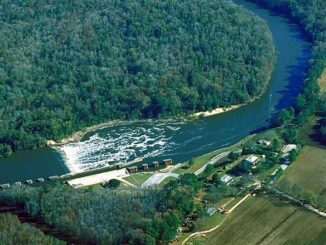
EUGENE, Oregon, October 31, 2025 (ENS) – The Upper Willamette Soil & Water Conservation District, UWSWCD, is planning to acquire a 200+ acre hazelnut orchard located on the lower McKenzie River to protect the drinking water of Eugene, a college city of about 200,000 people that hosts the University of Oregon.
Known as the Rice Farm, it’s one of the oldest working hazelnut orchards in Lane County.
Along with the orchard, the farm includes river and stream environments that are a vital source of habitat for fish and wildlife along Cedar Creek and the McKenzie River.
“This property has unique and important habitat values that create public conservation benefits, including improving and protecting the source of drinking water for many Lane County residents,” District Manager Lily Leitermann explained.
The Rice Farm is directly upstream from the Eugene Water & Electric Board’s sole drinking water intake source. It has long been identified by local conservation organizations as an irreplaceable piece of the puzzle for local water quality protection and restoration projects, Leitermann says.

The property has been valued at $5.8 million. Dietz is offering the district a gift of $1.8 million, reducing the asking price to $4 million.
From the time that the District received voter approval for a tax base in 2020, it has been developing a reserve fund to acquire property for conservation projects and an office. Leitermann reveals that those reserves now amount to enough to cover the cost of the Rice Farm purchase.
“As a tax-funded local government district, we use our funding to support local soil and water conservation efforts, working with partner organizations and private landowners,” she said.
While researching the land and various funding opportunities, the District found “many potential conservation projects as well as various funding sources to pursue long-term stewardship of the property,” she said.
The district’s first priority will be to focus on restoring riparian areas, improving water quality near the Eugene Water & Electric Board, EWEB, water intake, which will be an immediate benefit to fish and wildlife species as well as the drinnking water in Eugene and parts of neighboring Springfield.
The Freshwater Trust’s shade credit program would fund the removal of invasive plants, replacing them with native plant species along the McKenzie River and Cedar Creek.

Applied farming research opportunities with the University of Oregon and Oregon State University would help to reduce pesticides, herbicides and other chemicals, improving the soil health of the hazelnut orchard.
“We are committed to keeping the majority of the hazelnut orchards in production, working with a local farmer to manage the farm and using conservation practices that improve both soil health and water quality,” Leitermann said.
“In purchasing the Rice Farm, we intend to protect crucial working lands and wildlife habitat while continuing to support Eastern Lane County landowners, community-based organizations, and their regional partners in a wide variety of conservation projects,” she explained.
“We also plan to shift the hazelnut orchard operations to organic and apply sustainable practices throughout the farm,” Leitermann revealed. The district is seeking additional partnership support and funding for this environmentally-friendly endeavor.
The Upper Willamette Soil & Water Conservation District Board of Directors is expected to make a final decision on the Rice Farm property acquisition in November.
Featured image: The Upper Willamette Soil & Water Conservation District, UWSWCD, in Oregon is considering buying a 200+ acre hazelnut farm on the lower McKenzie River. Known as the Rice Farm, it is the second-oldest working hazelnut orchard in Lane County and includes river and stream habitats for fish and wildlife. undated. (Photo courtesy UWSWCD)
© 2025, Environment News Service. All rights reserved. Content may be quoted only with proper attribution and a direct link to the original article. Full reproduction is prohibited.



